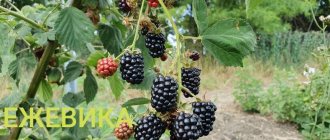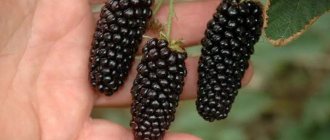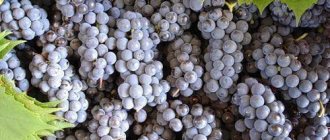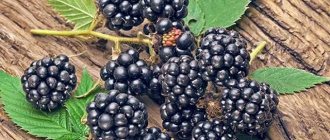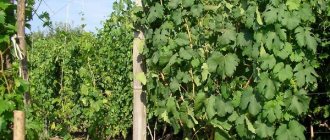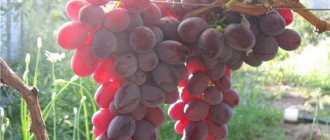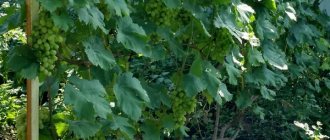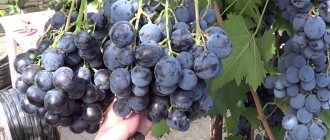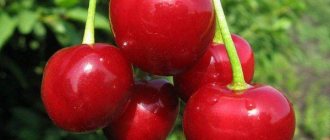Botanical description
In accordance with the information provided in the original patent, blackberries of this variety have the following biological characteristics:
- bush of straight type, medium size (about 1.5–2 m);
- forms a sufficient number of shoots and root shoots;
- leaves are large, spiny;
- the thorns on the shoots are very large, sharp and hard;
- the flowers are large, with a pink tint;
- very large berries - 10–13 g,
- the shape of the berries is oblong-round;
- color black, shiny;
- the taste is sweet or sour (1.9% acid).
Did you know? The high yield of blackberries is mentioned in
William Shakespeare’s play “Henry IV”, where he says:
“
If I had as many excuses on my lips as there are blackberries on the bushes...”
History of selection
The variety is native to the state of Arkansas, USA, and a patent certificate for it was received in 1996. Blackberries Arc.791 and Arc.1058 were used for breeding work at the University of Arkansas. According to the authors' tradition, the variety was named after the Kiowa Indian tribe.
Varietal features of Kiowa
Kiova blackberry is a late-ripening variety, grows as an erect bush, the height of the shoots exceeds 1.6 m. It is densely leafy, the leaves are painted in a bright emerald color. It blooms with white inflorescences with a soft pink tint.
In the summer, starting from mid-July, very large berries begin to ripen on the bushes - there is simply no other way to describe them. Some specimens weigh 20 g each, and on average the weight of one berry is about 15 g. The shape of the blackberry is standard, rounded and elongated, the color is black, with a glossy sheen. The seeds in the berries are small and almost invisible. The taste is dominated by sweet notes, there is very little sourness, but the aroma is amazing.
Characteristic
Kiowa blackberries have many impressive characteristics, but there are some drawbacks to consider. The indicators indicated by the breeder in the patent refer to the conditions in specific test fields. Under the conditions of a different climatic zone, as well as the specific location of the site, these indicators (fruiting time, minimum temperature in winter, etc.) may change. Yield parameters are given for plants with additional watering and regular fertilizing.
Drought resistance, frost resistance
According to official data, the plant can withstand temperatures down to -23°C. Reviews from gardeners indicate good endurance of the root system, but frequent freezing of shoots with an insufficient layer of cover. There is no information on the drought resistance of the variety.
Productivity, fruiting
In the Arkansas climate zone, Kiowa ripens in mid-June (from about the 12th to the 23rd). A special feature of this variety is that it bears fruit within 6 weeks, while other varieties produce berries within 4-5 weeks. Most of the berries form on the outside of the bush, making them easier to pick. The yield at home is 4-5 t/ha; domestic gardeners give data of approximately 10 kg per bush.
Video: Blackberries of the Kiova variety
Advantages and disadvantages
- The main advantages of the Kiova variety can be considered:
- very large and beautiful berries, with good taste;
- maintaining size until the end of fruiting;
- high yield within 6 weeks;
- rust resistance.
- The disadvantages of the variety most often include:
- severe spinyness of shoots and leaves;
- the need for shelter for the winter;
- average resistance to anthracnose.
Description of the Kiova variety
The Kiowa variety has a number of features, thanks to which it has become so loved by many gardeners and even industrial enterprises:
- The berries are large in size, deep black with a typical blackberry gloss. The average weight of one fruit hovers around thirteen grams, and record holders reach twenty grams. The shape of the ogina is conical, somewhat rounded. Kiowa tastes balanced between sweetness and acidity and has a dense and juicy texture. Medium sized achenes. The aroma is deep and has notes of wild berries. The productivity of Kiov is at a high level - with excellent organization of care and cultivation, they harvest up to 6 tons per hectare.
- The hybrid plant belongs to the brambles - its shoots are erect. The stems usually reach a height of one and a half meters. There are frequent and very sharp thorns on the bushes. The foliage is emerald green and the flowers are pinkish-white.
- Kiowa is considered frost-resistant - the bushes can withstand temperatures down to -23ºС. To be careful, you should not refuse to organize a shelter for the winter. However, you should not be too zealous, otherwise the buds will rot.
- In addition, the described species has good ability for transportation and storage. The berry will not lose its taste after several days in the refrigerator. There is a high level of immunity to diseases and pest attacks.
- Kiowa is considered far from early - in the southern regions the ripening process begins only in the second ten days of July. This varietal property limits the growing area; the hybrid should not be planted in places with harsh climatic conditions. The fruiting period itself is long - the berries are collected over 40 - 50 days.
- The fruits can be consumed both fresh and in a processed state (jam, compote, syrup, tincture and others). Blackberries retain their taste and aroma, vitamins and minerals even after the freezing process.
Landing Features
The biological characteristics of blackberries determine the importance of choosing the right site and observing the timing of planting the seedlings. It is necessary to take into account both the weather conditions of the region and the requirements of a particular variety. It is better to prepare the site and planting holes for blackberries 2-3 weeks before planting the plant in open ground.
Video: How to plant blackberries correctly
Deadlines
Since Kiova does not have high winter hardiness, it is best to plant seedlings in early spring . In this case, the young bush will have time to take root well and reserve strength to successfully overwinter. In the southern regions, autumn planting is possible, in September - early October.
Find out more about the features of autumn planting blackberries.
Selecting a location
The site for placing this berry bush should be sunny, without frequent strong winds . In the south, you can plant blackberries in a place with light partial shade to prevent the berries from burning from the strong summer sun. You should not plant the plant in flooded beds, as this will significantly reduce the frost resistance of the crop. Blackberries are often grown near fences or walls.
Pests that attack blackberries are also dangerous for raspberries, roses, rosehips and hawthorns, and strawberries. These plants should be planted at the greatest possible distance. The plant does not have any special requirements for soil composition, but carbonate and saline soils should be avoided.
Important! Using this variety as a hedge is possible only in regions with warm winters, where the plant does not need shelter.
Selection and preparation of planting material
The purchase of seedlings must be made in a trusted place . Specialized nurseries often provide the opportunity to taste the varieties they grow, so the gardener can evaluate the taste of the berries and the characteristics of the plant.
Purchasing a seedling at the market or in another unknown place cannot guarantee the varietal conformity of the crop.
A healthy blackberry seedling should have 1-2 strong shoots, whose girth should not be less than 5 mm. A developed root system will include at least one bud, and traces of rot or mold are not allowed.
Did you know? Ezhemalina
—
bred in 1923 in the USA, a hybrid of blackberries, raspberries and loganberries.
Planting scheme and process
Blackberry bushes have significant dimensions; the distance between two plants should not be less than 1–1.5 m. When planting several rows, the interval between rows is 2 m. When planting Kiova blackberries, you should take into account the need for winter shelter and the desired installation of a trellis. Despite the straight stems, mature fruiting shoots can fall to the ground under the weight of the berries.
A hole 40 x 40 x 40 cm is prepared for the seedling, into which a nutrient mixture of 5 kg of humus or compost, 40 g of potassium fertilizer and 100 g of superphosphate is poured. Then you need to cover the fertilizers with a layer of ordinary soil to protect the young roots from possible burns.
Further planting occurs in the following sequence:
- The plant is placed in a hole, carefully straightening the roots.
- The hole is covered with earth, covering the root buds by 2–4 cm. The soil is lightly compacted.
- The upper branches are shortened by 2-3 buds.
- Water each seedling with 3–6 liters of water, mulch the ground around it with a layer of compost, humus, hay, etc.
Blackberry Kiova: planting varieties
Photo of Kiowa blackberry
In order for the yield to be high, you need to start with proper planting of the bush. This process does not require special knowledge and skills and will not be difficult, but in order to achieve good results, some rules must be followed.
Planting occurs in the spring after the earth has warmed up. If you carry out planting activities in the autumn, then you need to do it in such a way that rooting occurs before frost begins.
Appropriate place:
Blackberries of the Kiova variety will grow well and bear fruit only if they are planted in an area with good lighting without shading. It is also very important that the site is protected from strong winds.
The soil:
Kiowa blackberries love light, nutrient-rich soil. In order to give the soil all these properties, you need to add sand and peat. If there is a high level of acidity in the soil, you need to add dolomite flour.
Buying a seedling:
When choosing a seedling, it is necessary that its root system is well developed and the plant has one living bud, one shoot and a leaf. The length of the spine must be at least 10 centimeters.
How to plant:
Before planting, you need to dig planting holes, the distance between which will be at least one and a half meters, lay out a drainage layer of broken brick or gravel at the bottom and fill it with fertile soil. You need to place the seedling on the small mound that you should end up with, carefully straightening its roots and placing it around it.
Afterwards, you need to sprinkle the roots with an earthen mixture of soil and organic matter. Next, you need to compact the soil and water it abundantly.
Please note that the root collar must remain above the surface of the earth.
After planting, you need to mulch the ground next to the bushes, using straw or peat, and then cut off the branches, leaving about 40 centimeters in length.
Rules of care
A high yield of large berries requires providing the plant with a sufficient level of moisture and nutritious soil.
We advise you to learn how to grow blackberries from seeds at home.
Planted seedlings should be watered 2-3 times a week for 1.5 months, then only in dry times. A bush that has entered fruiting needs to be provided with watering during periods of growth of young shoots and ripening of fruits.
To build up the root system and develop the bush, the soil in the berry garden must be loose and free of weeds. If the soil is not mulched, loosening is carried out:
- 5-6 times throughout the season in row spacing, 10–12 cm deep;
- 2-3 times throughout the season in the tree trunk area, carefully and not exceeding a depth of 5–8 cm.
To reduce the frequency of watering and the need for loosening and removing weeds, mulching with organic materials (compost, straw, humus, forest litter, etc.) is used. In addition, this technique further accelerates the ripening of blackberries.
Feeding fruit-bearing plants consists of autumn and spring applications of nutrients. The following scheme is most often used (per m²):
- in the fall, when digging, add 4-5 kg of organic matter (compost or rotted manure), 30 g of superphosphate and 40 g of potassium sulfate;
- In spring, the same amount of organic matter is covered with an additional layer of peat of 2-3 cm.
Pruning and shaping blackberries
The optimal trellis design consists of three horizontal wires stretched on stakes at a height of 50, 120 and 180 cm. Bush shoots are placed on it in one of the following ways:
- like a fan , spreading the fruiting shoots to the sides (alternately left and right), and the young ones upward;
- waves , bending adult branches along the lower horizontal lines in a wave-like manner, and young ones - on the upper wires;
- separately , when the shoots of the current year are diverted in one direction, and the fruit-bearing ones - in the other;
- ropes , when young shoots are left in the center, and adults are sent along the wire.
Important! Sharp spines on the shoots and leaves make pruning and covering work with blackberries much more difficult. It is necessary to protect your hands with leather gloves up to the elbows, and also use pruners with long handles.
Dividing the shoots into fruiting and young ones makes harvesting and pruning faster and easier.
After harvesting, the fruit-bearing branches are cut off to the very roots. At the same time, diseased or damaged shoots are cut out. Formative pruning during the season includes:
- shortening the tops by 10 cm when the shoot grows to 1 m;
- pruning side shoots to a length of 40–45 cm when they grow to 50–60 cm.
Subsequent care of the crop
Growing the Kiowa blackberry variety is quite simple. Even inexperienced gardeners do not have any particular problems when growing shrubs.
Growing principles
Although the shoots of the Kiova variety are erect and quite strong, it is still better to strengthen them on a trellis with a fan. This simple procedure will make it easier to care for and will not allow the branches to break under the weight of ripening berries, and will also simplify pruning and harvesting, because blackberry shoots are covered with sharp thorns.
The productivity of the Kiova variety is directly related to proper care of the plant. By following simple recommendations for caring for blackberries of this variety, you can achieve excellent results. You will have no reason to worry that the harvest will be meager.
Necessary activities
The need for watering for the Kiova variety is moderate. Systematic watering should be done from the beginning of flowering, because the quantity, size and quality of the developing fruits depend on the amount of moisture. To retain moisture, the soil is mulched with straw or peat.
Advice! If you use humus or compost as mulch, then each watering will turn into feeding the plant’s root system.
From the beginning of the budding period, it is advisable to fertilize blackberries by adding mineral supplements to the soil around the bush once every three weeks. Loosening and weeding are done as needed.
Shrub pruning
For erect blackberries, pruning of the side shoots is necessary to give the bush a compact shape and prevent them from growing chaotically.
Kiowa blackberries are pruned in spring and autumn. During spring pruning, dry and rotten shoots are removed. During the autumn season, young, weak shoots are pruned, as well as old, fruit-bearing branches remaining after the harvest. As a result, no more than 10 young and healthy shoots are left, which are also shortened a little, shortening by approximately 1/3.
Preparing for winter
After pruning, the blackberry shoots, before they become lignified, are removed from the trellises, and, carefully bending them down, they are placed under cover. Although breeders claim that the Kiova variety is frost-resistant, it is still not worth the risk, because in its homeland the climate is much milder and warmer.
Harvesting and storage
The grapes are harvested as they ripen to ensure the best flavor possible . Collection should be done only in dry weather; in the morning you need to wait until the dew dries. Kiowa blackberries tolerate transportation quite well, but for long-term transportation it is recommended to collect the berries 2-3 days before full ripeness.
Storage for 2 weeks is possible at a temperature of about 0°C and air humidity of about 90%. Without refrigeration, the berries will last 1-2 days. Blackberries can be used fresh, as well as for preparing various preparations and deep freezing.
History of selection
Blackberry Kiowa appeared at the turn of the century. Its creators are scientists from the University of Arkansas, who, by crossing two experimental varieties, obtained a miracle berry of incredible size and juiciness. The Kiowa hybrid has a second name - Kiowa, which is associated with the name of one of the Indian tribes. After receiving the first vegetatively propagated seedlings, the variety was patented and the first copies went on sale in 1995.
Note: The blackberry hybrid is considered to have the largest berries. New varieties of blackberries are appearing, but it is still one of the TOP 5 varieties with the largest fruits.
Preparing for winter
In most regions, it is recommended to cover Kiowa blackberries. To do this, the shoots are bent to the ground, tied into a bunch of several pieces, and pressed down with a load. After a few days, they are pinned down and covered with dense material.
Important! Under the shelter, protection against rodents is laid out, for example, a flap soaked in a solution of 500 ml of sunflower oil and 50 g of creolin.
Regular agrofibre is not suitable for this variety due to its very sharp thorns. You can use thick bags made of non-woven materials or put spruce branches first, and then cover them with film or thick spunbond.
The edges of the covering materials are pressed to the ground with boards or pipes. After snow falls, you can further increase its natural layer on covered plants
Landing rules
Proper planting is the key to achieving a high yield. There is nothing complicated in planting Kiova blackberries, but you still need to follow some rules.
Recommended timing
Blackberries of this variety are planted mainly in the spring, when the ground is warm enough. When planting Kiova blackberries in the fall, the timing is calculated so that the seedlings have time to take root before the first frost.
Choosing a suitable location
For planting, choose well-lit places protected from strong gusts of wind. Dark areas should be avoided.
Soil preparation
The soil where Kiowa blackberries are planted should be nutritious and light. You can add sand or peat to the soil, this will significantly reduce the density and enrich the composition of nutrients. If the soil is acidic, then it is limed using dolomite flour.
Reproduction methods
This variety of blackberry is propagated by cuttings from the root or root shoots. Seed propagation of the crop is also possible, however, the resulting plants, while retaining the characteristics of the variety, will begin to bear fruit only in 3-4 years.
An adult plant annually produces a certain amount of young root shoots. For propagation, a healthy bush is selected and shoots are dug up when their length reaches 10–15 cm at the beginning of summer . When transplanting, the total length of the seedling should not exceed 30–40 cm (starting from the bottom of the root system). The shoots are transplanted immediately to a permanent place or first placed in a separate bed, where they are grown until the fall.
Root cuttings are harvested in spring or late summer . To do this, the dug root, more than 5 mm thick, is cut into sections of 10–15 cm. The cuttings are laid out at a depth of about 10 cm, sprinkled with earth and ensure uniform moisture. Also, cuttings cut in the fall can be stored in the basement in damp sand and planted in the spring.
Features of care
In the middle climatic zone, it is recommended to plant Kiova seedlings in the spring after a thaw. The landing site should be sunny, protected from drafts and wind.
Shrubs are planted at a distance of at least 1.2 meters, but if accelerated agricultural technology is not a priority, compacted plantings should be avoided. The optimal distance between seedlings is 1.5-2 meters.
Kiowa blackberries are planted in the spring, when there is no possibility of return frosts.
The plant does not like acidic soil. For extinguishing, you can use ash or dolomite flour. It is important to fertilize the soil well so that it is light and nutritious. When planting, it is necessary to avoid contact of roots with fertilizer to avoid burns.
To simplify care, it is worth strengthening the bushes on a trellis. The first few years the shoots are actively growing and there is an opportunity to direct them correctly, “fan out” towards the sun. With the onset of cold weather, the shoots are removed from the trellis, shortened by about a quarter, rolled up and placed under cover. Any type of dense but breathable agrofibre, spruce branches, and burlap are suitable.
Despite the declared frost resistance, severe frosts are destructive for Kiowa blackberries. But at the same time, it is important not to overdo it with insulation, since the kidneys can resist.
The more freely the Kiowa blackberry bushes are planted, the higher the yield
If you properly fertilize the soil when planting, then in the future you should apply fertilizers every 3-4 years. During this period, it is necessary to monitor the condition of the leaves and the growth rate of the green part. If the indicators are insufficient, nitrogen-containing fertilizers are needed, and when the ovaries are formed, potassium fertilizers are needed.
Kiowa blackberry loves moisture, but does not tolerate its excess. It is important to avoid stagnation of water to avoid rotting of the rhizomes.
The ripeness of the fruit can be easily determined by its appearance. Ripe berries acquire a glossy black color. Harvesting can be done at intervals of 3-4 days. This is sufficient time for a new batch of berries to ripen.
You will find detailed rules for caring for blackberries in our material.
Diseases and pests
Possessing resistance to rust, this variety can be infected with other fungal diseases:
- anthracnose characterized by the appearance of purple spots on young shoots at the beginning of summer, which eventually become cankers. Leads to withering and drying out of all above-ground parts of the plant;
- didimella most dangerous for buds and shoots. This spotting leads to early defoliation and drying out;
- Septoria blight affects plants in wet weather, reaching maximum strength during the ripening of berries.
To prevent fungal diseases, it is necessary to avoid dense plantings and ensure the bushes are ventilated. You should also remove fallen leaves, dig up rows and destroy diseased parts of plants. An effective means of prevention is to treat young shoots and leaves with 1% Bordeaux mixture , and if the first spots are found, you can spray the bush with sulfur preparations or garlic infusion.
Possible crop pests include:
- raspberry stem fly, which flies out of the ground in May-June and gives life to larvae, which then gnaw holes in the shoots. To prevent insects from flying out, it is recommended to place a thick layer of mulch in the tree trunk circle of the bush. If the shoots begin to fade, they are removed;
- raspberry and blackberry aphids harm young shoots, which as a result easily freeze. For prevention in early spring, you can treat the bush with a 1% nitrafen solution;
- various pliers They feed on leaves, which then dry out and fall off. To combat them, loosening the soil, removing leaves and mulching, as well as sulfur preparations are used.
The Kiova blackberry variety impresses with the size of its berries and, with proper care, will provide a high annual harvest. Before choosing this variety, you should evaluate the efforts to care for a plant with strong thorns and winter shelter.
Blackberry Orkan: care
Blackberry Orkan: video about the variety
As we noted earlier, Orcan blackberry is considered an unpretentious plant, but you still need to follow certain agrotechnical rules. Only in this case the yield will be high and the quality of the fruit will be good. As we noted earlier, you will need to water the blackberry bushes quite intensively. For the first time, seedlings are watered immediately after planting the plants in open ground. After this, it is recommended to water the young plants twice every six to seven days. If an earthen crust begins to form, loosen the soil. Don’t forget to weed the area; weeds take away not only nutrients, but also moisture. Plants are not watered so intensively; usually mature blackberry bushes need one watering per week. Moisture must penetrate well into the soil, so the soil must be loosened in a timely manner so that the structure of the earth is air and water permeable. Blackberries are usually pruned in the fall, removing stems that bear fruit. Young shoots will also need to be pruned in a timely manner; they interfere with the development of the main bush. It is recommended to leave no more than 7 powerful and strong branches and shoots on each bush. In summer, you can shorten their tops by trimming the stems by a few centimeters. This way, you can stimulate the formation of new side branches, which means that the blackberry yield will also increase. In early spring, before sap flow begins, do not forget about sanitary pruning; all frozen and deformed shoots must be removed, they interfere with the development of plants and fruiting of the crop. It is considered easiest to prune plants that are grown on supports, so try this method of cultivating the crop. For supports, you can use a metal pipe, as well as a wire that is stretched between the rows. Biennial and annual shoots will definitely need to be separated and directed along supports in diametrically opposite directions. Preparing bushes for winter by growing them this way is also easier. The fact is that you can easily form the slope of the branches immediately after they begin to develop and grow. But in the fall it is more problematic to carry out this procedure, since the shoots during this period of time become more fragile and thicker. If your site has sufficiently fertile and nutritious soil, then you will need to start feeding the plant at the age of three. An adult Orkan blackberry bush needs quite a lot of humus, compost, mineral and organic fertilizers, since these components directly affect the taste of the berries. That is why it is recommended to spread compost over the area in early spring, and also apply urea under the bushes. It is undesirable to apply chlorine-containing fertilizers to the soil, but potassium fertilizers have a good effect on the development and growth of shrubs. Before wintering, the stems of the plant must be removed from the supports and covered. If your region has little snow in the winter, this procedure is mandatory, otherwise the plant may die during the winter. The shoots must be bent to the ground and covered with spruce branches or straw. It is believed that it is good to cover the bush with snow, so if possible in winter, rake it up to the bush. It is best to use any breathable material for protection; agrofibre is also suitable for shelter.
Growing and care
In order to obtain a large harvest, Loch Ness blackberries require good care.
Watering
Blackberries do not require frequent watering and do not like stagnant water. Only young seedlings require constant watering, so they will take root faster and form green mass faster. Watering is carried out at least once every 2 weeks, when dry, hot weather sets in: once a week. Adult bushes are watered only during very dry periods, as well as during flowering and berry setting.
Trimming
Pruning must be approached individually in each specific case. The fact is that Loch Ness grows quite well in width and additional pruning can lead to excessive thickening and reduced yield.
The main pruning is carried out in spring and autumn, removing weak shoots, as well as those affected by pests and diseases, throughout the summer season. At the end of spring, the shoots are shortened by 10–15 cm, and the lateral growths are trimmed. Then they tie it in the form of a fan to the trellises, separating last year’s and new shoots. In the fall, old, broken or dried shoots that have finished bearing fruit are removed. The bushes are thinned, leaving 4–6 stems, and the rest are cut off. In this case, there should be no stumps left. Stumps can rot and become a source of infections, as well as be a “house” for pests.
Top dressing
The Loch Ness variety needs feeding starting from the third year; for the first two years, the plant is quite sufficient with the nutrients added to the hole during planting.
In spring, fertilizing is carried out with nitrogen fertilizers, for example, urea. The main task of spring feeding is to enhance the growth of green mass. Starting from mid-summer, priority is given to potash and phosphorus fertilizers. They have a beneficial effect on the structure and taste of the fruit, and also help the bush prepare for winter.
In addition to the listed elements, blackberries require calcium, boron, iron and other elements, so it would be useful to use complex mineral complexes. Wood ash is an excellent organic fertilizer for blackberries.
Treatment against diseases and pests
The Loch Ness hybrid is also popular among gardeners because it demonstrates good resistance to various pests and diseases. But preventative treatments are still necessary.
Immediately before starting to prepare the plant for winter and in the spring before the buds open, spray the bush with 1% Bordeaux mixture or any other copper-containing preparation. Many reviews talk about spraying blackberries with sulfur-containing preparations. Such recommendations are not accidental. Sulfur prevents the development of fungal diseases and has a negative effect on various types of mites.
Preparing for winter
One of the advantages of Loch Ness blackberries is their resistance to frost. It tolerates cold well down to – 20C. But in winter, temperature changes can be sharp and significant, so it is still worth preparing the shrub for winter. Although this procedure is somewhat more difficult to complete than with creeping hybrids.
The branches are carefully removed from the supports, collected in a bunch, laid on the ground and sprinkled with peat, sawdust or fallen leaves (but not from fruit trees, as they may harbor insect pests). Can be covered with agrofibre (density not lower than 60 g/m2). In areas where there is a lot of snow, it is enough to carry out snow retention measures. The snow will cover the stems with a thick layer and serve as the best “blanket” for the plant.
It is best to winter this type of blackberry together with trellises. In this case, the bushes are less susceptible to mechanical damage. However, folding trellises are only common on farms. Self-production of this type of trellis at home is more likely to be the preserve of craftsmen with golden hands and not everyone can do it.

